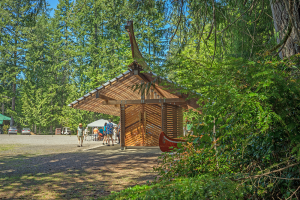GHC Carpentry Program Completes Canoe House
Posted on: May, 17, 2023
This spring, GHC joined community partners in celebrating the completion of the canoe house at Camp Bishop.
On Saturday, May 13, the Carpentry program at Grays Harbor College (GHC) participated in the dedication and ribbon cutting ceremony for Camp Bishop’s newly constructed canoe house. The celebration market the culmination of a collaborative effort between GHC’s Carpentry program, the YMCA of Grays Harbor, and various community partners.
Students from GHC’s carpentry program had the unique opportunity to contribute to the construction of the canoe house. The students worked in partnership with the Aberdeen Museum, the Grays Harbor Community Foundation, Vern Heikkila, Will Foster, and many other community partners.
The canoe house was designed and built to store a 25-foot restored Old Town Canoe, which was used in a water safety program that the American Red Cross funded in 1946. The canoe was later used in programming at Camp Bishop in the 1970s.
The dedication and ribbon cutting ceremony featured speakers who had been involved with various phases of the project. Vern Heikkila, who was present at Camp Bishop's construction in 1954, reminisced about the camp's history and the significant contributions of community volunteers. Heikkila shared that 700 individuals had come together in 1954 to build Camp Bishop's dining hall and several cabins in a single day. Nearly 70 years later, volunteers gathered once more to celebrate the successful completion of another community-driven project at Camp Bishop, the canoe house.
After discovering the canoe at the Aberdeen Museum, Heikkila got involved with canoe restoration and began working on the canoe in 2013. Once he had completed restoration, he was presented with another challenge: what was he going to do with the 26-foot canoe?
Heikkila reached out to Will Foster, who would become another leader in the project, about building a shed to store the canoe. Eventually, it became clear that a shed wasn’t adequate. According to Foster, they needed something that would respect the craftsmanship of the canoe. Designs of a canoe house eventually surfaced. The structure would have curved ribs that mimicked the shape of the canoe. It would be made of timber, a reference to the timber mills found in the Pacific Northwest for many years. The top of the canoe house would feature traditional cresting, drawing upon elements from indigenous cultures throughout the region.
Once designs were finalized, it was time to build. Foster shared that he knew Adam Pratt, one of GHC’s Carpentry instructors, through the Woodworkers Guild. “I knew Adam pretty well and heard a lot about the Carpentry program and what they accomplished throughout the years,” he said. Looking at the canoe house as he spoke to the crowd, Foster added, “Thanks to Adam and his students, we have a work of amazing craftsmanship.”
Building the canoe house presented challenges and many learning opportunities for the Carpentry students. Pratt reflected on their involvement, highlighting the complexity of the blueprints and the additional obstacle of the project's location—an hour's drive from GHC's campus. Despite these hurdles, the Carpentry students devoted their time and expertise to the project. “We made jigs and fixtures for almost everything we did here, and a lot of problem solving,” said Pratt.
In addition to technical and problem-solving skills, Pratt shared that building the canoe house gave Carpentry students the chance to improve craftsmanship and critical thinking skills. It also provided students with the chance to take pride in their work, see the bigger picture, and contribute to a legacy that will serve generations. “This wasn’t about a canoe and it wasn’t about a canoe house. This was about community,” said Pratt. “This was an opportunity to leave a legacy to this camp and the community.”
Learn More about Carpentry at GHC
Carpentry students at GHC receive hands-on training with the tools of the trade in the various phases of residential construction, as well as building codes, drawings, estimation, math, and layout. There is a strong emphasis placed on work habits and safety. The Carpentry Technology program teaches the fundamental skills required for those seeking a career in construction or career advancement. Those wishing to explore carpentry as a career and those with personal interests in carpentry are also welcome.
Space is available in classes beginning this fall. Students enrolling in workforce training and education programs, including Carpentry, may be eligible forfunding, resources, and support to reach career goals through Workforce Funding and Support Program .
